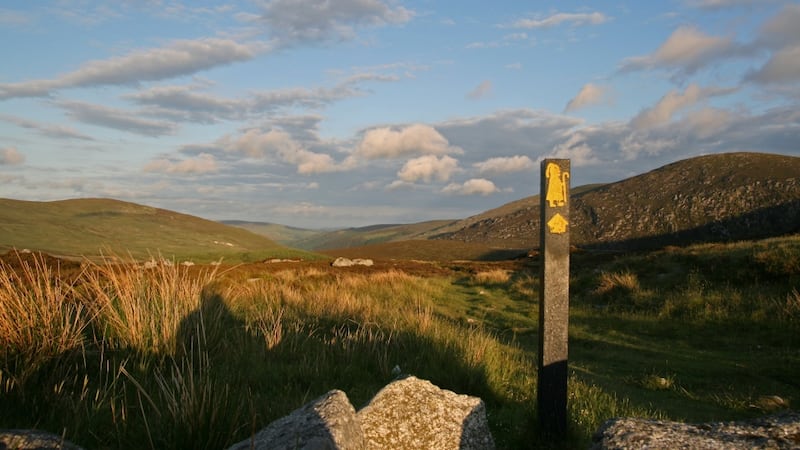|
St. Kevin's Way, Co Wicklow
Startpoint: The head of the Wicklow Gap (460m) which lies at the highest point of the main R756 between Hollywood and Laragh |
Easy as it is to blame the growth of rampart materialism for the 20th century decline in the honourable Irish tradition of footing it to a sacred destination, the real culprit is almost certainly the automobile.
Early pilgrims usually followed the line of least resistance for they sought, after all, not fitness, flat tummies or sublime scenery but spiritual renewal. These rights-of-way eventually morphed into modern, high-speed tarmac roads to accommodate the seemingly insatiable demands of the car.

Boot-burning bitumen and endless streams of traffic are not welcoming to walkers. On the Spanish Camino de Santiago, for example, separate walking routes have been placed – where necessary – alongside but shielded from main highways. The problem with the first section of St Kevin’s Way, the ancient pilgrim route beginning in Hollywood, Co Wicklow, is that the obvious route beside the R756 is not initially used. Instead, the trail wanders tortuously along minor roads for about 12km and then dives in and out of what are mostly boring stands of commercial timber. As a result, those seeking an undemanding outing will lose little by following the footsteps of St Kevin from the head of the Wicklow Gap.
And so on a bright autumnal morning, I followed a pleasant, if rather soggy trail downhill from the Gap before crossing the road to Lough Nahanagan and then skirting a forest. Here, ancient flagstones of the old pilgrim path were still visible. Beyond these the route crossed a stile to join a gravel track leading across a stream to the main R756.
This road excursion was mercifully short, however, and then it was off-road again at a scenic bridge for a spectacular descent into Glendasan.
Soon I reached the extensive ruins of a once thriving lead mine. During the worst of the famine, these mines kept starvation at bay by employing up to 200 men.
Next the path followed the right bank of the Glendasan River, later passing a couple of Christian retreat houses. I headed down by the riverside on a compelling enclosed sylvan track and entered the haunting, secluded valley, where the St Kevin spent his life in prayer and contemplation.
Having first visited the extensive monastic ruins of St Kevin’s ancient city, I then made my way to the Upper Lake and the tranquil beauty of the tightly enclosed valley. I fell for Glendalough on my first visit over three decades ago, and now, I wondered why. After all the Kerry Mountains are higher and more spectacular, Connemara more rugged and untamed, Donegal staggeringly lonesome and wild.
Then gazing across the still waters the reason comes to me. The attraction of Ireland west lies with a wildly random mountain extravaganza, austere, forbidding and untamable. The beauty of Glendalough, however, is on a simpler, less awesome scale.
Here is a truly intimate grandeur where people are gently absorbed by a landscape possessing near perfect harmony, as if created by an all powerful heavenly architect.